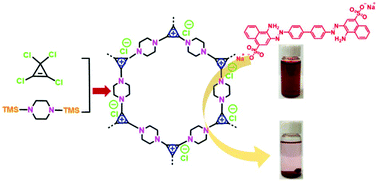Ionized aromatization approach to charged porous polymers as exceptional absorbents†
Abstract
Ionic porous polymers have received great attention in gas adsorption, as catalysts, and for water purification due to their substantial porous and charged structures. However, the development of such types of materials is hindered owing to the lack of either suitable ionic functional monomers or efficient polymerization methods. In this work, we report a one-step ionized aromatization polycondensation of two neutral monomers, tetrachlorocyclopropene and disilylated bis-amines. The resulting cyclopropenium cation-linked porous polymers feature unique skeletons with charge-extended distribution, deformability, and containing a substantial number of amino groups, which leads to unusual capture capabilities toward various guest molecules. Physical absorption of nonpolar N2 is largely governed by the intrinsic shape-persistent structural character of the polymers, while excellent CO2 uptakes of up to 2.2 mmol g−1, are mainly attributed to their high polar amino-containing cationic skeletons. For the 1,4-piperazine-based porous polymer, its ultra-high selective capture of anionic dyes in water (e.g. Congo Red, 3480 mg g−1), among the highest values for documented porous materials, is synergistically driven by its unique extended cationic charge and transformable skeleton.



 Please wait while we load your content...
Please wait while we load your content...